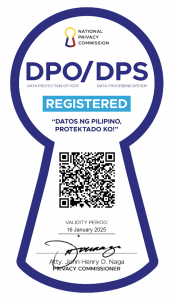PROFILE OF REGION 10
Strategically located in the southern part of the Philippines’ resource-rich island of Mindanao, Northern Mindanao or Region 10 is a highly-diversified region that enjoys quality living and sustained economic growth. It is home to the Phividec Industrial Estate, the country’s largest industrial estate that hosts light to medium industries. The region is also a site to big multi-national corporations which existed for decades.
Northern Mindanao Quickstats
INDICATORS | DATA | REFERENCE |
4,689,302 | August 2015 | |
Land Area | 20,186 sq km | 2010 |
Average Annual Family Income | P221,000 | 2015 |
Average Annual Family Expenditure | P161,000 | 2015 |
Annual Per Capita Poverty Threshold (in Php) | P22,345 | 2015 |
Poverty Incidence (among Families) | 30.3% | 2015 |
Poverty Incidence (among Population) | 36.6% | 2015 |
GRDP (in thousand pesos; at Constant 2000 Prices) | P283,238,432 | 2015 |
GRDP Growth Rate | 5.5% | 2014-2015 |
Consumer Price Index (2006=100) | 156.8 | Dec. 2016 |
Inflation Rate | 2.4% | Dec. 2016 |
Purchasing Power of Peso | 0.64 | Dec. 2016 |
Labor Force Participation Rate | 67.2% | Oct. 2016 |
Employment Rate | 95.9% | Oct. 2016 |
Unemployment Rate | 4.1% | Oct. 2016 |
Underemployment Rate | 26.9% | Oct. 2016 |
It is an ideal business location. The international seaport and container terminals, serving the region and the rest of Mindanao, are considered the most efficient outside Metro Manila. Electricity is reliable and relatively cheap, water is abundant and telecommunications are modern. There is a large pool of skilled, English-speaking and highly-trainable workforce. In summary, the region prides the following advantages:
- Presence of power generation service
- Vast agricultural lands and rich natural resources
- Strategic location
- Huge potential for industrial development
- Peace-loving people, and skilled and literate workforce
Economic Performance – GRDP Growth Rate
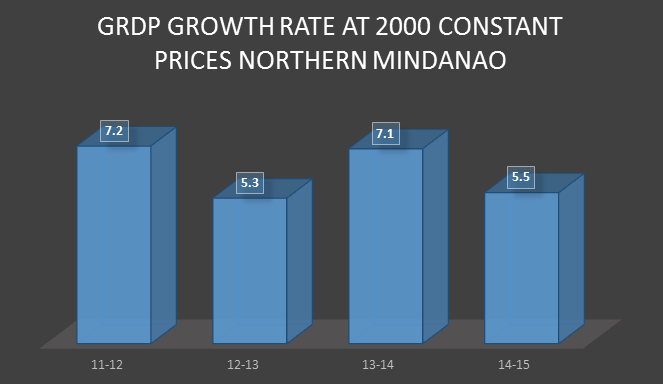
GRDP-Gross Regional Domestic Product
Structure of the Economy
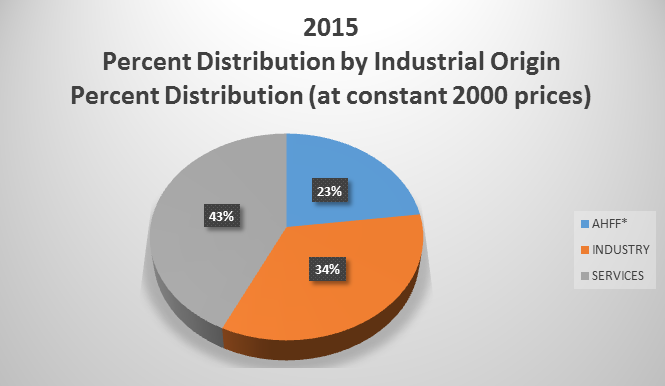
*AHFF-Agriculture, Hunting, Fishing & Forestry
Top 10 Export Commodities of Region 10 – First Quarter, 2016
- Oleochemicals
- Canned Pineapple Products
- Coconut Oil
- Abaca Fiber, Processed
- Sintered Ore
- Desiccated Coconut
- Fresh Pineapple
- Cane Raw Sugar
- Coconut Shell Charcoal
- Copra Meal/Cake
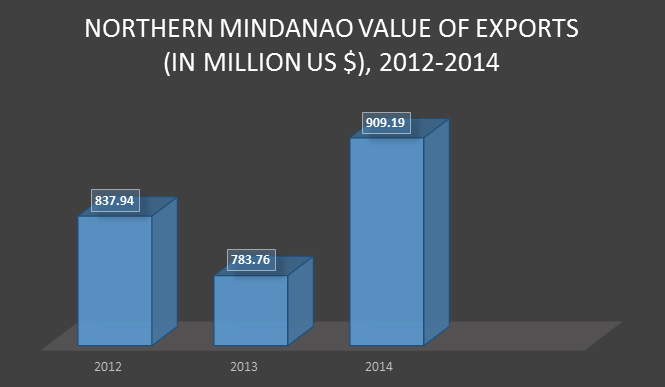
Investment Opportunities
Growth and investment opportunities in the region thrive in agriculture, food processing, tourism, service-related industries, trade infrastructure services, and industrial, environmental, and ecological support facilities.
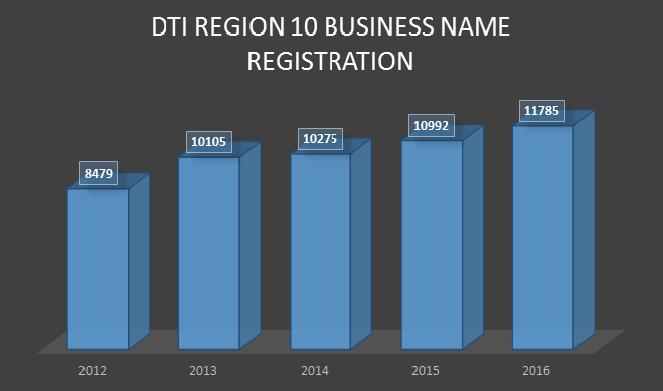
Phividec Industrial Estate Priority Locator Industries
- Manufacturing
- Steel/Metal
- Shipbuilding
- Food Processing
- Port Logistics and Ancillary Services
PIE-MO Incentives
- Low land lease rates
- Exemption from customs duties and taxes if goods are 70% for export
- Availment of Board of Investments (BOI) and/or Philippine Economic Zone Authority (PEZA) privileges if eligible for registration
BOI Privileges
- Income Tax Holiday (ITH)
- Exemption From Taxes And Duties On Imported Spare Parts
- Exemption From Wharfage Dues And Export Tax, Duty, Impost and Fees
- Tax Exemption On Breeding Stocks and Genetic Materials
- Tax Credits
- Additional Deductions From Taxable Income
PEZA Privileges
- Income Tax Holiday (ITH), 4-8 years
- 5% Special Tax on gross income, after ITH in lieu of all local and national taxes
- Value Added Tax (VAT) zero-rating
Provincial Trade and Industry Profiles
Northern Mindanao has five provinces, namely, Misamis Oriental, Misamis Occidental, Bukidnon, Lanao del Norte and Camiguin. It comprises two (2) highly-urbanized cities, seven (7) constituent cities, 84 municipalities and 2,022 barangays.
Misamis Oriental
Among the five provinces under Northern Mindanao is Misamis Oriental. Based on Philippine Statistics Authority’s records in 2015, Misamis Oriental already has a population of 889 thousand, excluding the population of Cagayan de Oro. The highly-urbanized city of Cagayan de Oro alone has a population of 602 thousand.
Misamis Oriental’s strategic location allows it to qualify as a centre of industry, trade and commerce in the region. To date, there are already 37 major industrial and manufacturing firms that are based in Misamis Oriental.
Misamis Occidental
Rich in aquamarine and agricultural products, Misamis Occidental is seen to get more economic opportunities in the future. The province is also open to eco-tourism investments since its location is efficient to most ports in Northern Mindanao and since it also has a wide range of pristine natural grandeur.
The province boasts off its long coastline where one of the country’s shrimp spawning grounds is located. Aside from shrimps, Misamis Occidental also offers other aquamarine resources such as shellfishes, prawns and crabs which will eventually pave its way to become the aquamarine centre of the Philippines.
Camiguin
Camiguin – also known as the “Paradise Island” of Mindanao – boasts off its scenic sea and mountain views, natural hot and cold springs and white beaches. Camiguin is located 90 kilometres north of Cagayan de Oro. Anyone coming from Cagayan de Oro can take a 45-minute boat ride through the Benoni Port to reach the province of Camiguin. The province has a population of around 88 thousand and has a land area of 292 square kilometre.
Bukidnon
Bukidnon, the province which sits at the heart of Mindanao, gets a taste of every benefit each province in Region 10 enjoys. The province has a good road system that is very accessible for those who are travelling by land through Cagayan de Oro and through other entry points in Mindanao. It is also located in an area where the climate is very ideal for foreign and local dwellers. Bukidnon’s vast land of pineapple and other produce allows it to perform remarkably in the agri-business industry. In fact, two of the country’s biggest pineapple companies – Del Monte Philippines and Dole Philippines – have been operating in the province for years. Meanwhile, several adventure and eco-tourism parks have also added to the province’s popularity, making it one of the top go-to places for tourists visiting the Philippines.
Lanao del Norte
The province of Lanao del Norte vaunts its 153,738 hectares of developed agricultural land, a rich coastline for aquamarine produce, and some private fishing grounds. Coming along the launching of the Cagayan-Iligan Industrial Corridor is the support from downstream and major industrial plants. The province also has a lot of potentials in the agri-business sector and can push through its global aim to become one of the top agro industries in the province.



